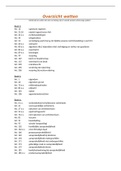Samenvatting
Summary Systems Approach in Animal Sciences
This summary includes the theory from the lectures of the course and from the lecture notes provided in the course, as well as the explanation and relevant information from the assignments.
[Meer zien]













